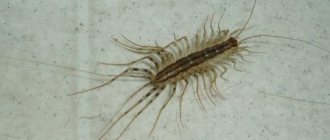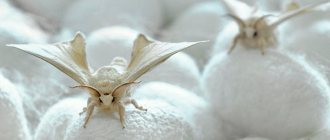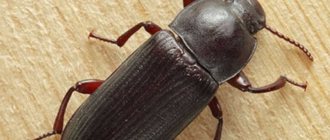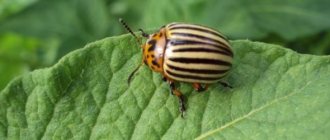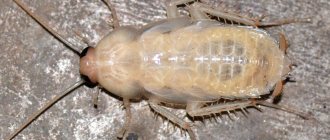Owning a home outside the city is the dream of almost every person who wants to live away from the hustle and bustle, in nature. However, the suburban area is literally teeming with a variety of miniature enemies. They calmly manage gardens and vegetable gardens, but they also feel quite comfortable in the house, becoming very unpleasant neighbors. Since not a single building erected outside the city is built without wooden planks, sooner or later the owners are faced with a direct and obvious threat - the bark beetle, a great admirer of wood. An insect that is not caught at the crime scene in time can cause enormous damage to a structure. Therefore, it is better to find out in advance why the bark beetle is dangerous in the house, and about methods of combating the small pest.
You need to know the enemy by sight
The bark beetle is a member of the Coleoptera family and is called the most dangerous wood eater. At first glance, he seems to be an absolutely innocent creature, but the impression is deceptive: a large army of such “fighters” is capable of destroying hectares of coniferous forests in a short time.
This is an insect whose length is less than 10 mm, color is dark brown or black, the head is often darker than the body, and antennae stand out on it, ending in a characteristic “club”. This subfamily includes about 140 species found in Europe. The most famous bark beetles are the spruce beetle, the sapwood beetle, and the pine beetle, with the first being considered the most dangerous. If we compare insects by food preferences and structure, then bark beetles are closest to weevils.
Bark beetles inhabit the house in families. These social units can be monogamous (a male with a female) or polygamous (several females). The type of family plays a role: females belonging to different types of colonies gnaw their own, special, passages. They are so different in structure that entomologists can almost instantly determine the type of pest. They just need to look at the cut of wood, at the structure of the “built corridors”.
It is not easy to detect pests, since they are nocturnal and spend most of their time inside the wood. There they tirelessly make passages, lay eggs, and come out for only one purpose - to find a partner for mating. A feature of bark beetles is their incredible fertility, so even a small “company” can grow into a huge colony in just a couple of years. To notice traces of the presence of a threat, it is necessary to regularly and carefully examine all wooden surfaces.
The danger of bark beetles
Trees (deciduous, coniferous) are the natural habitat of this type of insect. Having penetrated the wood, the beetle feels at home: there it can find food and protect itself from any danger. Females, gnawing passages to the very core of a woody plant, lay eggs.
A week later, larvae hatch from them, which with great appetite are taken for juice and fiber. One tiny individual is able to eat approximately 10 g of wood per day, while simultaneously making tunnels for itself in a new home. In winter, the larvae hibernate, but do not die, since temperatures down to -30° are not scary for them. They grow for about 3 years, after which they become pupae, and then adults, which begin to actively reproduce.
Bark beetles migrate from tree to tree, but do not shy away from wooden buildings or certain elements thereof. They gnaw passages in them, then lay eggs. The beetle larvae begin to make their own individual “tunnels.” Young insects emerging from pupae are also busy making new passages. Some species of bark beetles additionally construct ventilation ducts and mating shelters (bark beetles), intended for repeated mating.
The result is the gradual transformation of buildings into dust. Such houses already pose a direct threat to the people living there: load-bearing walls, interior partitions, and ceilings can settle, tilt, or even collapse at any moment. Some species of bark beetles are able to carry mold spores. Everyone knows about the seriousness of this danger.
Bark beetles and building materials
Warehouses and lumber warehouses are a haven for these insects, so attacks (or rather, raids) of beetles are not that uncommon. In this case, the owners of the future house may “run into” contaminated wood even before construction. To eliminate the risk of buying with a “surprise” you need to take precautions:
- a thorough check of the lumber is required: tiny holes and narrow paths on the surface are a clear symptom of “bark eating”;
- when purchasing round timber, you need to pay special attention to the ends of the logs; there should be no suspicious defects on them;
- the favorite food of beetles is tree sap, so purchasing dry material is a chance to avoid getting acquainted with dangerous insects;
- a new house requires mandatory treatment with antiseptic solutions (Antizhuk, Wood Doctor, Ekolan-41): it is better to carry out the operation three times, the interval is a week or 10 days.
When buying a wooden house, a serious check of all surfaces of the structure is a necessary measure, since unscrupulous sellers-owners often, precisely because of the beetle infestation, try with all their might to quickly get rid of the dilapidated structure, but to get at least some money.
Furniture is another possible way for the bark beetle to enter the house. In this case, contamination of wooden structural elements is almost inevitable.
Applying bark beetle plaster
So, the interior has been thought out, ready-to-use or dry bark beetle plaster has been purchased, the surfaces have been prepared. What's next?
- Tools for applying bark beetle
To apply this textured plaster yourself, you will definitely need: a smooth spatula and a grater - choose the size for yourself individually, but preferably close to medium, as well as a container for plaster, water and a mixer for stirring.
Even if you buy a ready-to-use mixture, it must be thoroughly stirred before use to make the structure homogeneous.
If you mix the dry mixture with water yourself, be sure to follow the proportions indicated on the packaging - this is the key to successful application of the material.
At this time, it would also be correct to take care of the color of the future plaster; it is much more effective to add dye to the plaster mixture than to then paint already finished walls. The colorant must be added to the entire batch of the mixture at once - otherwise, the shade will not be the same for the entire volume of material and this will be very noticeable on the treated surfaces. The finished plaster must be thoroughly mixed so that there is no uneven structure or gaps in the shade left anywhere.
- Ideal layer for application
The mixture must be applied in a thin layer - ideally, its thickness should correspond to the grain size of the plaster. This can be done with a spatula or a grater - whichever is more convenient for you.
The tool should be positioned at an angle to the surface being processed. The main requirement here is to try to make the layer of plaster as uniform and even as possible relative to the wall. Make sure that there are no bulges or other irregularities on it.
- Grout
You need to start it when the plaster “sets” a little, does not polymerize completely, but only thickens a little. You need to catch this moment practically experimentally, but approximately this happens 30-40 minutes after application. This is done with a grater. You need to rub in the “Bark Beetle” with smooth, even movements, without making much effort. If you press the float too hard, the pattern can be completely smoothed out, and you will just get a plastered wall.
For beginners, traditional designs are preferable - rain, waves, circles - they are easy to perform and quite popular. To get “rain” on the surface, the grater needs to be moved along the wall, moving up and down.
“Circles” are obtained by rubbing the plaster in a circle, respectively. A wavy design can be easily achieved by using a grater to create smooth, wavy lines. You can easily create your own, unique design - there is a huge scope for experimentation!
- Nuances when applying
The “bark beetle” is not particularly fastidious in its work, there is only one nuance that needs to be taken into account - once you start one wall, do not interrupt the work until you finish it, otherwise you may get a visually noticeable “joint” at the place where the work will begin after complete drying plaster. Of course, completing all the finishing work, even of one room, at one time is not easy even for professionals, therefore, try to divide the room into zones and work so that in one go, apply the material to one zone.
- Drying time
For complete drying, Bark Beetle can take from one to five days - depending on the brand, layer thickness and room temperature. After the plaster has dried, you can paint the surface if the dye was not added directly to the mixture. Or, if necessary, coat with protective varnish.
If you want to get a strong and durable coating, be sure to pay attention to this type of decorative plaster. This finish is truly luxurious, spectacular and practical.
Signs of the presence of insects
The bark beetle in the house is almost a “partisan”; it will not appear in front of the owners, poking itself in the “chest” with its paw. Cautious creatures feel comfortable inside a tree, and crawl out into the light when everything around is dark and quiet. Therefore, the chance of meeting him is small, but you can still understand that something is wrong.
- The first alarming symptom is tiny holes (1-2 mm) that appear on wooden walls, ceilings, sheathing, and furniture. Where there are passages, “traces of the crime” must remain - light yellow wood dust. It (drill flour) is easy to find on the floor, near the holes.
- The second sign is extraneous sounds. Wood-boring beetles cannot work silently: in the midst of work and eating, the bark beetle (probably) forgets about caution. Therefore, at night, home owners may hear a sound somewhat reminiscent of a clock ticking. Only the original measuring instruments must be removed from the room.
In order to take timely action, it is better to regularly and very scrupulously inspect all wooden surfaces. Only constant checking will make it possible to quickly detect and get rid of the “misfortune” as quickly as possible.
Bark beetle in the house: fight for a tree
At the first suspicious sign of the presence of danger, you need to begin to act. You can start a war against bark beetles using traditional methods. If you cannot get rid of the beetles, you will have to use more effective drugs and traps. When it is not possible to drive out a living threat, they call in the “heavy artillery” - professionals who have strong insecticides in their arsenal, guaranteeing complete disposal of the invaders.
Traditional methods of fighting beetles
One cannot hope for a miracle if bark beetles have been successfully carrying out “subversive activities” in wood for quite a long time. Folk recipes cannot be called super-powerful weapons; they can only help if the infection has occurred recently. The following insecticides are usually used:
- Kerosene with turpentine. The ingredients are mixed in a ratio of 1:3, the surface is treated with the product using a spray bottle or a sponge (brush), and it is poured with a syringe with a thick needle into the passages made by the bark beetle.
- Rosin, paraffin and vegetable oil. The second component is melted, rosin is added (4:5), the mixture is brought to a boil. Then add 1 part of the oil, boil the composition for a few more minutes. They use the product in exactly the same way.
- Tar, naphthalene, turpentine. Prepare the mixture, the ratio is 1:1:3. Apply similarly to the first two insecticides.
- Vaseline oil. This drug is injected directly into the passages. The procedure is performed with a syringe without a needle.
To prevent the enemy from escaping from the “battlefield,” the holes, if there are only a few of them, are sealed with acrylic or silicone sealant. A week later, the treatment is repeated, after 2 weeks the passages are again treated with the selected composition.
There are several more original methods. They say insects don't like sulfur smoke bombs. Burning several pieces at the same time makes it possible to get rid of an unpleasant neighborhood. Bark beetles do not like strong stomping and vibration. It is impossible to say for sure how true this statement is.
A more severe infection is a sufficient reason to use radical methods. If the area is severely damaged, it is cut off and then burned. A new element cut to the shape of the hole is attached to the damage site. It is also treated with bark beetle repellent.
Chemical professionals
The extensive area affected by bark beetles requires the help of industrial insecticides. To get rid of insects, but not harm the owners, you must follow the instructions and do not change the proportions at your discretion. For their own protection, use goggles, gloves, and a respirator.
You can get rid of several insects that have entered the house with Dichlorvos or Karbofos. If a colony appears, then the struggle for territory begins in earnest. One or more of the following drugs are usually recommended:
- Antishashelin. It is a long-acting drug and is not addictive. It is used for injecting beetle passages.
- BI-58. It affects bark beetles of any age (stage of development). The duration of action is short - 3 weeks, so the treatment must be repeated several times.
- Clipper. The product is suitable for impregnation and spraying of surfaces. It has a high degree of penetration, but also lasts only 3 weeks.
- Confidor Extra. The duration of action of the drug is a month, so several treatments following each other are a prerequisite.
- Senezh Insa is a universal antiseptic. Its differences from competing chemicals are its high penetrating ability and a record lifespan of 3 decades.
Other popular compositions are Antibug (Neomid 100), Wood Healer, Empire 20 (Xulate C25). When processing wood, children, pets, aquariums and plants should not be in the house. After treatment, it is better to immediately leave the room and wash thoroughly using detergents. It is recommended to enter the house only after thorough ventilation.
Ambiguous odorous traps
On the one hand, this method is gaining popularity. On the other hand, it has quite a lot of opponents. A “trap” for bark beetles is a plastic structure consisting of a glass and a funnel. Inside it is platinum impregnated with pheromone - a famous substance that attracts individuals of the opposite sex.
The device works simply: a beetle, smelling a wonderful aroma, flies on a “date”, but forgets about caution, so it hits a plastic partition. The result is falling inside the trap, to the bottom of the glass - into a prison from which escape is impossible. Safety is the main advantage of the method, but the effectiveness and feasibility of using such “beetle snares” is questionable. And that's why:
- This method allows you to catch only those who have already acquired wings. The larvae are not yet able to perceive the smell, but it is not the beetles that cause the maximum harm to the tree. Only adult insects will disappear, but these worms and eggs will remain living in the wood, “without blowing a feather.”
- Pheromone traps can attract all bark beetles located nearby - at a distance of several kilometers. Owners who decide to catch insects will be forced to face entire “hordes” of enemies. The result will not please you; on the contrary, it will plunge you into despair.
Pheromone traps will be effective in large gardens where seedlings are grown. The bark beetle in the house requires other methods of control.
Professional processing
A serious enemy who uses the latest weapons to wage war is “doomed” to victory. Therefore, by turning to specialists, you don’t even have to think about possible damage. To combat insects, two methods are used - using gas attack and radiation.
Fumigation with poisonous phosphine
It is a colorless poisonous gas, its derivatives are the notorious sarin and soman. Previously, phosphine was used to combat mice and rats that “encroached” on granaries. The process of getting rid of bark beetles is the treatment of passages made by insects.
The gas, penetrating into the wood, kills all living things. After using phosphine, long-term ventilation is required - for several days. Then you need to check the gas concentration and dispose of its residues. Therefore, the owners will have to leave the house for an indefinite period.
Microwave method - a safe alternative
This method is now used much more often, as it is effective, but absolutely harmless. High-frequency radiation, known to all owners of microwave ovens, operates here. The wood is heated to a certain temperature (60°).
The device is called a microwave insecticide. This procedure guarantees a similar result - complete elimination of “aggressors” of any stage of development, but the structure of the wood remains without any changes.
There is one prerequisite for using an insecticide. This is the absence of any metal elements in the tree - nails, screws, staples, etc.
Microwave treatment against bark beetle
Another professional method of pest control is high-frequency electromagnetic radiation treatment. A special microwave installation warms up the wood affected by the bark beetle using a microwave emitter. When heated to 60°, woodworms at any stage of development die. This type of treatment is not dangerous for wooden structures.
In the fight against bark beetles, it is important to choose a method that 100% destroys adult insects, larvae and eggs. Thus, population growth is interrupted and the emergence of new generations is excluded. In the case where it was possible to get rid of the beetles, and the clutches of eggs remained unharmed, there is a high probability of restoration of the population after a certain period of time.
Bark beetle in the house: prevention
It's better than a protracted war. The bark beetle may not appear in the house if measures are taken in advance to prevent the settlement of an unpleasant and dangerous neighbor. In this case, you must first create unfavorable conditions for insects on the site, and then come to grips with the house itself.
Work as a "precinct"
- Making feeders to attract feathered “forest nurses” is the first necessary step.
- Deprivation of comfortable places for life, breeding of beetles. It is necessary to remove all stumps, old, dead branches, and dead wood. It is best to remove all wood debris from the site as quickly as possible.
- Spring whitewashing of trunks with slaked lime. Composition: 1 part “unquenchable” material and 1.5 to 3 parts water. The components are combined in a container and left alone for an hour, during which the reaction will take place. Then the liquid is stirred and left again for an hour or two. They whitewash trees wearing gloves.
- Spray them after flowering. For this purpose, Bitoxibacillin, Boverin or Lepidocid are used. A homemade analogue consists of water (5 liters), liquid green soap (2 cups) and carbolic acid (2 cups). Before use, the composition is diluted - part solution + 4 parts water). After half a month, the procedure is repeated.
- Regular tree inspection. It consists of searching for suspicious holes. When bark beetle passages are detected, branches and trunks are immediately treated with insecticides. For example, Vitalizer NV-101. This drug is not only safe for plants, but also promotes their growth.
- Taking urgent measures in case of large infestation. In this case, chemical drugs are called to the rescue. If the tree cannot be saved by any means, the plants are cut down and then burned. They even get rid of the roots, since some types of bark beetles prefer to settle closer to the ground.
Prevention at home
- High humidity is contraindicated for wood, but it is precisely this that attracts insects that prefer “juicy” food. Therefore, the first thing to do is buy a hygrometer, create unfavorable conditions - ventilate, dry, ensure a low level of humidity.
- Getting rid of old wooden objects, regular cleaning of the room with constant checking of all “tasty” surfaces for the bark beetle for passages. These are procedures that should become the rule, not the rare exception.
- The last type of protection is the application of paints and varnishes to the wood. Special products for caring for varnished wood (Gloss, Polish) can also repel insects.
Unvarnished, unpainted surfaces are treated with a solution of sodium silicofluoride (200 g per 10 liters of water). The resulting composition is wiped over the wood using a soft cloth.
A bark beetle in the house is not a death sentence, since it will still be possible to get rid of uninvited guests: in a simple or more complex way. The main thing is timely detection of the enemy, because a comfortable, quiet residence of several individuals after a few years can turn into occupation.
What those owners who are already “lucky enough” to encounter an enemy insect advise, you can find out from the video:
Prevention of occurrence
As already mentioned, it is much better to carry out a set of preventive measures to prevent the appearance of bark beetles than to then destroy them and engage in restoration work due to the destructive activity of the beetles.
The main measures to ensure protection against these insects are:
- Treatment of the surfaces of all wooden buildings with reliable varnishes, antiseptics and other protective coatings , which will simultaneously protect against fungal formations and environmental influences on the wood.
- Timely destruction of affected trees , since it is most likely impossible to save them anyway, but they can cause the spread of a global epidemic.
- Maintaining trees in a healthy condition, periodically feeding and using various fertilizers. These measures are necessary because bark beetles in most cases choose weakened and diseased trunks to attack.

